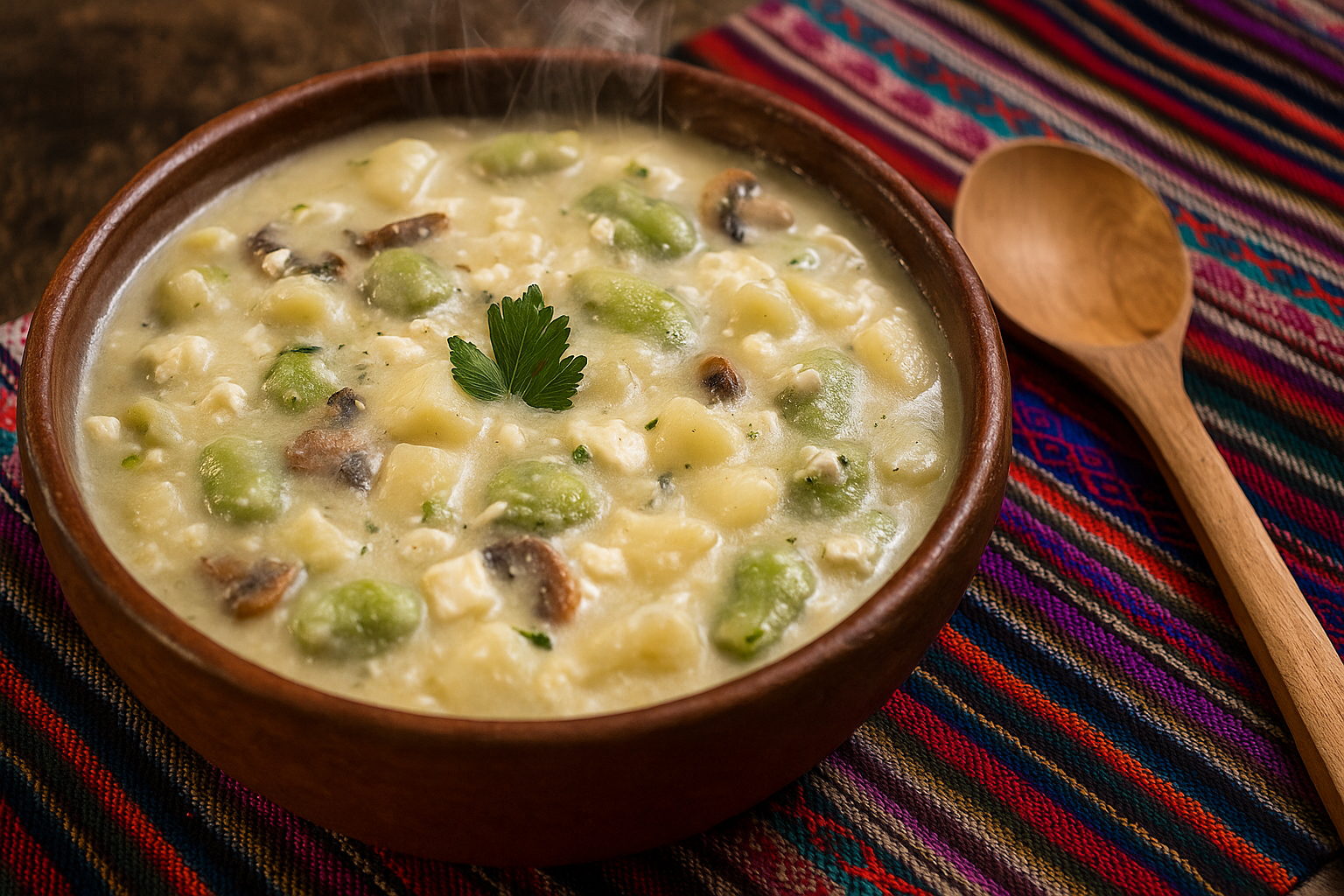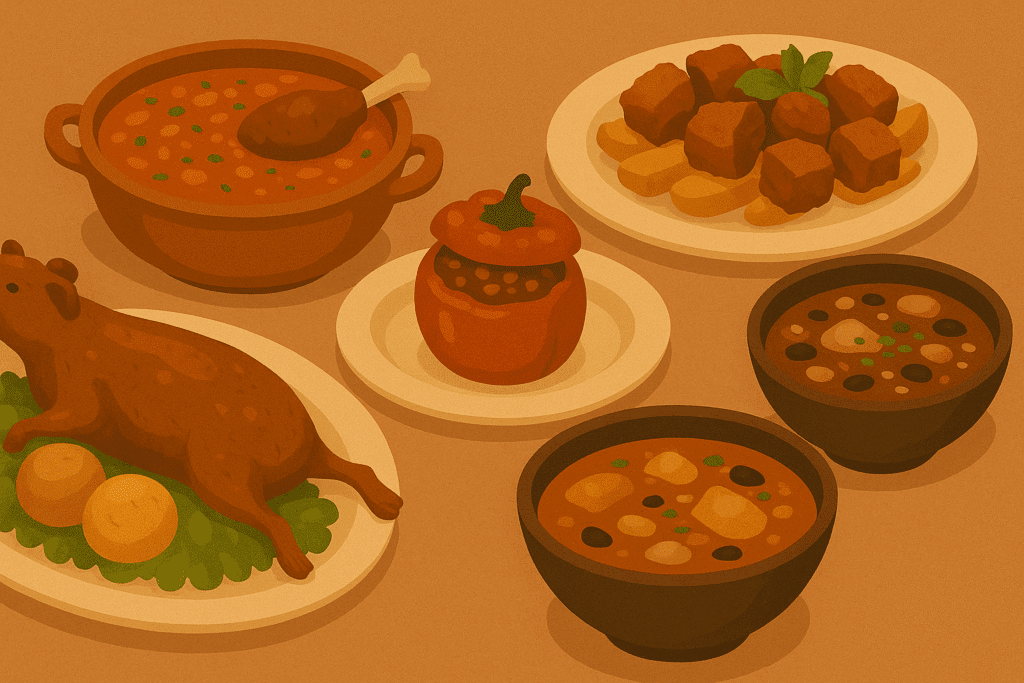Kapchi de habas is more than just an Andean dish; it's a celebration of the land, the harvest, and the cycle of life in the highlands. With its creamy texture and mild flavor, hinting at huacatay and chili, it is a comforting, ancestral dish deeply linked to the cultural memory of southern Andes.
This peasant stew is typical of regions such as Cusco, Apurímac, and Ayacucho. It has stood the test of time, remaining faithful to the rainy season, when the beans are at their most tender, and to the traditions that saw its birth. Today, we rediscover it spoonful by spoonful.

📜History of Broad Beans Kapchi
The kapchi, also spelled qapchi or capchi, comes from the Quechua word q'apchi, meaning "food cooked with chopped ingredients." This dish is part of the Andean agricultural legacy and originated in communities that knew how to make the most of seasonal ingredients.
During the Andean summer (January to March), when fresh broad beans sprout vigorously, families cook this dish as part of their agricultural rituals. Originally vegan, kapchi was adapted to include dairy products when European cattle were introduced, resulting in the current version with cheese and milk.
It is served during communal work as an offering to Pachamama or as a snack after working in the fields during the day.
🤔 Curiosities of Broad Beans
- In some areas of Apurímac and Cusco, it is finished cooking with hot stones inside a clay container, like a liquid watia.
- In Ayacucho, it is served as a festive breakfast, accompanied by serrano bread or mote.
- The fresh cheese used is artisanal, made from free-grazing cow's or goat's milk.
- In certain communities, it is considered a cleansing dish, ideal after abundant celebrations.
- Some contemporary chefs have reinvented kapchi in gourmet versions with foams, emulsions or reduced vegetable milk.
🔬 Nutritional Value of Broad Beans
- They are rich in vegetable proteins, which makes them an excellent alternative to complement the diet without meat.
- They provide dietary fiber, which improves digestion, regulates blood sugar and prolongs satiety.
- They contain iron, folic acid and zinc, essential for the formation of red blood cells and the strengthening of the immune system.
- They are a source of natural antioxidants, such as flavonoids, which fight cellular aging.
- Thanks to their low glycemic index, they are ideal for maintaining stable energy levels.
For all these reasons, bean kapchi is a naturally balanced and healthy dish, ideal for high altitude climates and active lifestyles.
📍 Culture Importance
Kapchi is more than a recipe: it is part of the Andean agricultural and spiritual calendar. It is intimately linked to:
- The rainy and harvest season
- The Feast of the Earth or Harvest
- Mingas (shared communal work) (trabajo comunal compartido)
- The daily diet of farming families, with products from the environment.
📌 Ingredients
This dish needs time, patience and love, like any good tradition.
| 🛒 Ingredients | 📌 Quantity for 4 diners. |
|---|---|
| Fresh peeled broad beans | 500 g |
| Medium potatoes | 4 |
| Fresh cheese | 200 g (cubed) |
| Evaporated or fresh milk | 1 cup (optional) |
| Onion | 1 (finely chopped) |
| Yellow chili | 1 |
| Vegetable oil or lard | 2 tablespoons |
| Salt | to taste |
| Water | quantity needed for cooking |
| Huacatay branch (optional) | 1 |
🍲 Preparation
- Heat the oil or lard in a medium saucepan. Add the onion and aji amarillo. Sauté over medium heat until the onions are transparent and fragrant.
- Add the chopped potatoes and just enough water to cover them. Add salt to taste. Cook over medium heat until almost done, about 10 to 12 minutes.
- Once the potatoes are almost cooked, add the fresh beans. Cook for an additional 5 - 7 minutes, or until tender.
- Add the cream cheese and, if desired, the evaporated milk. Stir gently so that the cheese begins to melt slightly. Cook 2 - 3 minutes more.
- For aroma and freshness, add finely chopped huacatay leaves. Turn off the heat and let it stand for a few minutes before serving.
You can serve it with white rice or mote, or enjoy it alone as it is traditionally served in Andean communities.
✨ Conclusion
Broad Beans Kapchi is a tasty and nutritious dish that symbolizes the harmony between humans and nature. It represents cycles, harvests, and the art of cooking with what the earth provides.
Whether served at a peasant's table, in a traditional restaurant, or in a modern setting, this stew remains a symbol of the living, respectful, and spiritual cuisine of the Andes. Tasting it allows you to understand the green heart of Peru.





